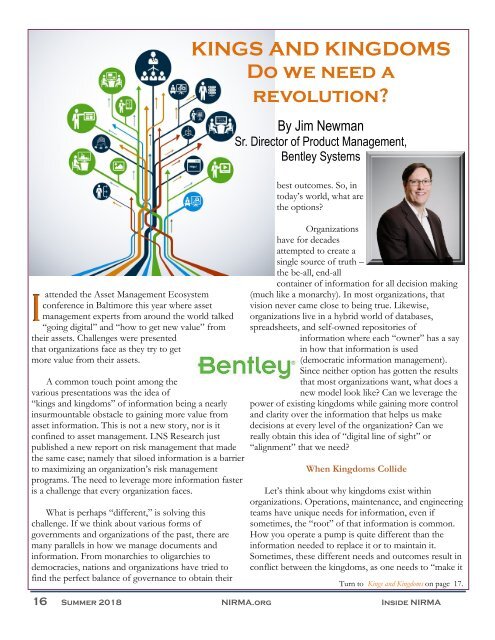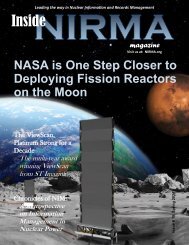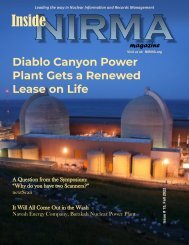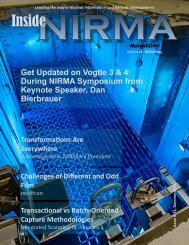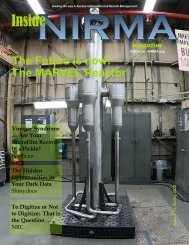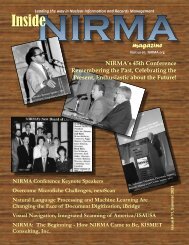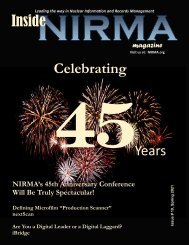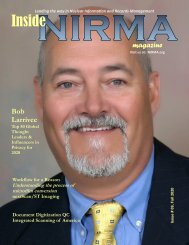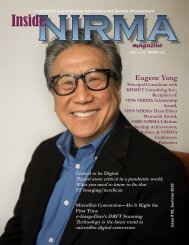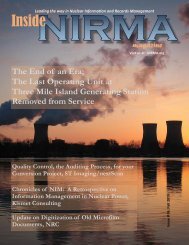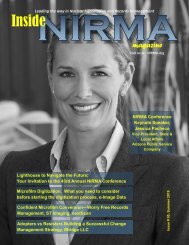Inside NIRMA Magazine Summer 2018 - FINAL
Create successful ePaper yourself
Turn your PDF publications into a flip-book with our unique Google optimized e-Paper software.
attended the Asset Management Ecosystem<br />
conference in Baltimore this year where asset<br />
management experts from around the world talked<br />
“going digital” and “how to get new value” from<br />
their assets. Challenges were presented<br />
that organizations face as they try to get<br />
more value from their assets.<br />
A common touch point among the<br />
various presentations was the idea of<br />
“kings and kingdoms” of information being a nearly<br />
insurmountable obstacle to gaining more value from<br />
asset information. This is not a new story, nor is it<br />
confined to asset management. LNS Research just<br />
published a new report on risk management that made<br />
the same case; namely that siloed information is a barrier<br />
to maximizing an organization’s risk management<br />
programs. The need to leverage more information faster<br />
is a challenge that every organization faces.<br />
What is perhaps “different,” is solving this<br />
challenge. If we think about various forms of<br />
governments and organizations of the past, there are<br />
many parallels in how we manage documents and<br />
information. From monarchies to oligarchies to<br />
democracies, nations and organizations have tried to<br />
find the perfect balance of governance to obtain their<br />
KINGS AND KINGDOMS<br />
Do we need a<br />
revolution?<br />
By Jim Newman<br />
Sr. Director of Product Management,<br />
Bentley Systems<br />
best outcomes. So, in<br />
today’s world, what are<br />
the options?<br />
Organizations<br />
have for decades<br />
attempted to create a<br />
single source of truth –<br />
the be-all, end-all<br />
container of information for all decision making<br />
(much like a monarchy). In most organizations, that<br />
vision never came close to being true. Likewise,<br />
organizations live in a hybrid world of databases,<br />
spreadsheets, and self-owned repositories of<br />
information where each “owner” has a say<br />
in how that information is used<br />
(democratic information management).<br />
Since neither option has gotten the results<br />
that most organizations want, what does a<br />
new model look like? Can we leverage the<br />
power of existing kingdoms while gaining more control<br />
and clarity over the information that helps us make<br />
decisions at every level of the organization? Can we<br />
really obtain this idea of “digital line of sight” or<br />
“alignment” that we need?<br />
When Kingdoms Collide<br />
Let’s think about why kingdoms exist within<br />
organizations. Operations, maintenance, and engineering<br />
teams have unique needs for information, even if<br />
sometimes, the “root” of that information is common.<br />
How you operate a pump is quite different than the<br />
information needed to replace it or to maintain it.<br />
Sometimes, these different needs and outcomes result in<br />
conflict between the kingdoms, as one needs to “make it<br />
Turn to Kings and Kingdoms on page 17.<br />
16 <strong>Summer</strong> <strong>2018</strong> <strong>NIRMA</strong>.org <strong>Inside</strong> <strong>NIRMA</strong>


